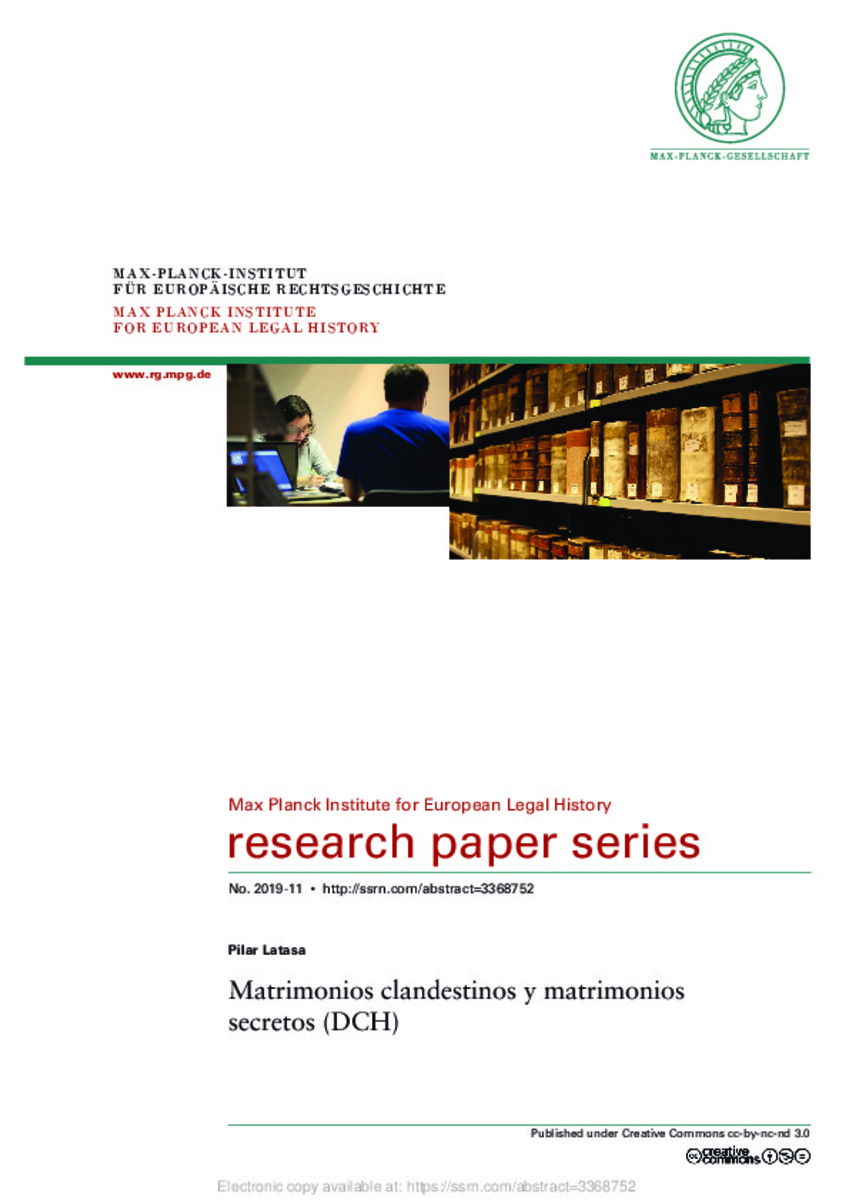Full metadata record
| DC Field | Value | Language |
|---|---|---|
| dc.creator | orcid.org/0000-0001-9365-043X | - |
| dc.date.accessioned | 2019-04-15T09:31:03Z | - |
| dc.date.available | 2019-04-15T09:31:03Z | - |
| dc.date.issued | 2019-04 | - |
| dc.identifier.citation | Latasa, Pilar, Matrimonios clandestinos y matrimonios secretos (DCH) (Clandestine Marriages and Secret Marriages (DCH)) (April 8, 2019). Max Planck Institute for European Legal History Research Paper Series No. 2019-11. Available at SSRN: https://ssrn.com/abstract=3368752 | es_ES |
| dc.identifier.uri | https://hdl.handle.net/10171/56690 | - |
| dc.description.abstract | Spansish Abstract: El artículo estudia los matrimonios clandestinos y secretos con el fin de explicar tanto sus semejanzas – principalmente, la falta de publicidad – como sus diferencias. Se explica por qué el matrimonio clandestino – como transgresión – y el matrimonio de conciencia o secreto – admitido por la jurisprudencia – constituyeron dos maneras excepcionales de casarse. Esta excepcionalidad debe entenderse en el marco de la reforma tridentina del matrimonio que, por el decreto Tametsi de 1563, estableció que la forma canónica – presencia del propio párroco y de dos o tres testigos y publicación de amonestaciones – fuera condición ineludible para que se produjera el vínculo matrimonial. Sin embargo, el frecuente recurso a la dispensa de amonestaciones evidenció la necesidad pastoral de eludir la publicidad del matrimonio en determinados casos y abrió el camino para la definitiva regulación del matrimonio secreto por Benedicto XIV en 1741, con la bula Satis vobis. El trabajo analiza esta normatividad y su impacto en Hispanoamérica y Filipinas entre los siglos XVI y XVIII; examina también los cambios y continuidades que se dieron en el proceso de adaptación del derecho canónico y las leyes castellanas a la peculiaridad indiana. | es_ES |
| dc.description.abstract | English Abstract: The article studies clandestine and secret marriages in order to examine both their similarities – mainly, the lack of publicity – and their differences. It explains why clandestine marriages – as a transgression – and secret marriages – as a legal practice – were two exceptional ways of getting married. This exceptionality must be understood within the framework of the Tridentine reform of marriage, which, by the Tametsi decree of 1563, established that the canonical form – presence of the parish priest and of two or three witnesses, together with the previous publication of admonitions or banns – was a requirement for the validity of the bond. However, the frequent resort to the dispensation of banns evidenced the pastoral necessity of avoiding the publicity of marriage in certain cases and opened the way for the definitive regulation of the secret marriages by Benedict XIV in 1741, with the Satis vobis papal bull. The work analyses this normativity and its effect in Spanish America and the Philippines between the XVI and XVIII centuries; it also examines the legal changes and continuities that appeared in the process of adapting Canon Law and Castilian laws to the American idiosyncrasy. | es_ES |
| dc.description.sponsorship | Max Planck Institute for European Legal History | es_ES |
| dc.language.iso | spa | es_ES |
| dc.publisher | Max Planck Institute for European Legal History | es_ES |
| dc.rights | info:eu-repo/semantics/openAccess | es_ES |
| dc.subject | Matrimonio clandestino | es_ES |
| dc.subject | Amonestaciones | es_ES |
| dc.subject | Matrimonio secreto | es_ES |
| dc.subject | Concilio de Trento | es_ES |
| dc.subject | Clandestine Marriage | es_ES |
| dc.subject | Secret Marriage | es_ES |
| dc.subject | Council of Trent | es_ES |
| dc.subject | Banns | es_ES |
| dc.title | Matrimonios clandestinos y matrimonios secretos (DCH) | es_ES |
| dc.type | info:eu-repo/semantics/bookPart | es_ES |
| dc.relation.publisherversion | https://ssrn.com/abstract=3368752 | es_ES |
| dc.publisher.place | Frankfurt am Main | es_ES |
| dc.description.note | Voz del Diccionario de Derecho Canónico en Hispanoamérica y Filipinas https://dch.hypotheses.org Published under Creative Commons cc-by-nc-nd 3.0 | es_ES |
| dadun.citation.author | Max Planck Institute for European Legal History | es_ES |
| dadun.citation.endingPage | 43 | es_ES |
| dadun.citation.number | 11 | es_ES |
| dadun.citation.publicationName | Max Planck Institute for European Legal History Research Paper Series | es_ES |
| dadun.citation.startingPage | 1 | es_ES |
| dadun.citation.volume | 2019 | es_ES |
Files in This Item:
Statistics and impact
Items in Dadun are protected by copyright, with all rights reserved, unless otherwise indicated.






